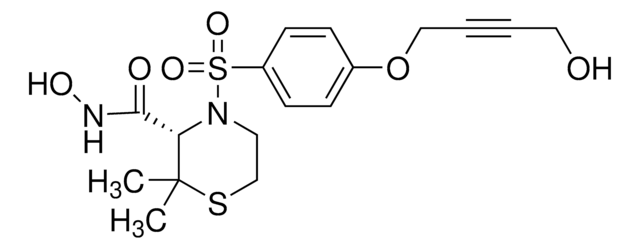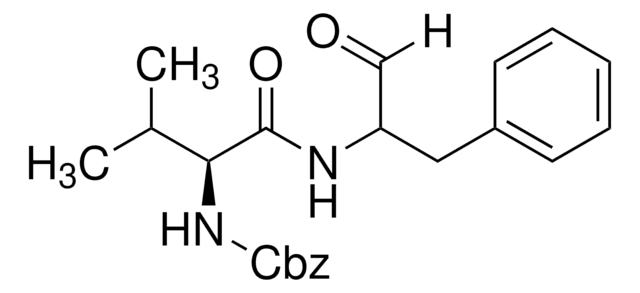208733
Calpain Inhibitor Set
The Calpain Inhibitor Set controls the biological activity of Calpain. This small molecule/inhibitor is primarily used for Protease Inhibitors applications.
Synonym(s):
Calplain inhibitor
Sign Into View Organizational & Contract Pricing
All Photos(1)
About This Item
UNSPSC Code:
12352200
NACRES:
NA.77
Recommended Products
Quality Level
form
solid
potency
8 nM Ki
manufacturer/tradename
Calbiochem®
storage condition
OK to freeze
desiccated
protect from light
shipped in
ambient
storage temp.
−20°C
General description
Calpains are a family of calcium-dependent thiol-proteases that act on a wide variety of cytoskeletal, membrane-associated, and regulatory proteins. There are two major isoforms: calpain I (µ-form) and calpain II (m-form), which differ in their calcium requirement for activation Calpains are composed of heterodimers of 80 kDa and a 30 kDa subunits. The 80 kDa unit has the catalytic site and is unique to each isozyme, whereas the 30 kDa unit is the regulatory subunit and is common to both µ- and m-isozymes.
More recently, attention has been focused on the pathological significance of calcium accumulation in the central nervous system following cerebral ischemia and traumatic brain injury. Over-activation of NMDA, kainate, and AMPA receptors in the brain leads to sustained influx of Ca2+ through the voltage-gated calcium channels. Overexpression of calpains has been positively linked to both acute and chronic neurodegenerative processes including ischemia, trauma, and Alzheimer′s disease. In Alzheimer′s disease the ratio of active (76 kDa) to inactive (80 kDa) µ-calpain is reported to be much higher Calpain-dependent proteolysis is usually the late-stage common pathway towards cell death induced by excitotoxic compounds, hence, a selective inhibition of calpains to limit neuronal damage appears to be a viable therapeutic measure.
More recently, attention has been focused on the pathological significance of calcium accumulation in the central nervous system following cerebral ischemia and traumatic brain injury. Over-activation of NMDA, kainate, and AMPA receptors in the brain leads to sustained influx of Ca2+ through the voltage-gated calcium channels. Overexpression of calpains has been positively linked to both acute and chronic neurodegenerative processes including ischemia, trauma, and Alzheimer′s disease. In Alzheimer′s disease the ratio of active (76 kDa) to inactive (80 kDa) µ-calpain is reported to be much higher Calpain-dependent proteolysis is usually the late-stage common pathway towards cell death induced by excitotoxic compounds, hence, a selective inhibition of calpains to limit neuronal damage appears to be a viable therapeutic measure.
Contains 5 mg of ALLN (Cat. No. 208719), 25 mg of Calpain Inhibitor III (Cat. No. 208722), 5 mg of Calpeptin (Cat. No. 03-34-0051), 1 mg of EST (Cat. No. 330005), and 5 mg of PD 150606 (Cat. No. 513022).
Biochem/physiol Actions
Cell permeable: yes
Primary Target
calpain 1, calpain 2
calpain 1, calpain 2
Reversible: no
Packaging
Packaged under inert gas
Warning
Toxicity: Multiple Toxicity Values, refer to MSDS (O)
Other Notes
Johnson, G.V.W., and Guttmann, R.P. 1997. BioEssays19, 1011.
Kampfl, A., et al. 1997. J. Neurotauma14, 121.
Sorimachi, H., et al., 1997. Biochem. J.328, 721.
Bartus, R.T., et al. 1995. Neurol. Res.17, 249.
Wang, K.K.W., and Yuen, P-W. 1994. Trends Pharmacol. Sci.15, 412.
Saito, K., et al. 1993. Proc. Natl. Acad. Sci. USA90, 2628.
Goll, D.E., et al. 1992. BioEssays14, 549.
Kampfl, A., et al. 1997. J. Neurotauma14, 121.
Sorimachi, H., et al., 1997. Biochem. J.328, 721.
Bartus, R.T., et al. 1995. Neurol. Res.17, 249.
Wang, K.K.W., and Yuen, P-W. 1994. Trends Pharmacol. Sci.15, 412.
Saito, K., et al. 1993. Proc. Natl. Acad. Sci. USA90, 2628.
Goll, D.E., et al. 1992. BioEssays14, 549.
Legal Information
CALBIOCHEM is a registered trademark of Merck KGaA, Darmstadt, Germany
Storage Class
11 - Combustible Solids
Certificates of Analysis (COA)
Search for Certificates of Analysis (COA) by entering the products Lot/Batch Number. Lot and Batch Numbers can be found on a product’s label following the words ‘Lot’ or ‘Batch’.
Already Own This Product?
Find documentation for the products that you have recently purchased in the Document Library.
Customers Also Viewed
Pradoldej Sompol et al.
Aging cell, 20(7), e13416-e13416 (2021-06-13)
Inhibition of the protein phosphatase calcineurin (CN) ameliorates pathophysiologic and cognitive changes in aging rodents and mice with aging-related Alzheimer's disease (AD)-like pathology. However, concerns over adverse effects have slowed the transition of common CN-inhibiting drugs to the clinic for
Azizul Haque et al.
Experimental neurology, 330, 113315-113315 (2020-04-18)
Parkinson's disease (PD), a debilitating progressive degenerative movement disorder associated with loss of dopaminergic (DA) neurons in the substantia nigra (SN), afflicts approximately one million people in the U.S., including a significant number of Veterans. Disease characteristics include tremor, rigidity
Related Content
Select different protease inhibitor types based on your needs to prevent protein degradation during isolation and characterization and safeguard proteins in sample prep.
Our team of scientists has experience in all areas of research including Life Science, Material Science, Chemical Synthesis, Chromatography, Analytical and many others.
Contact Technical Service





![1,1′-[4,8-Bis[5-(2-ethylhexyl)-2-thienyl]benzo[1,2-b:4,5-b′]dithiophene-2,6-diyl]bis[1,1,1-trimethylstannane]](/deepweb/assets/sigmaaldrich/product/structures/611/912/a638a6fe-ca7b-4674-8023-df4c0921a9fd/640/a638a6fe-ca7b-4674-8023-df4c0921a9fd.png)





